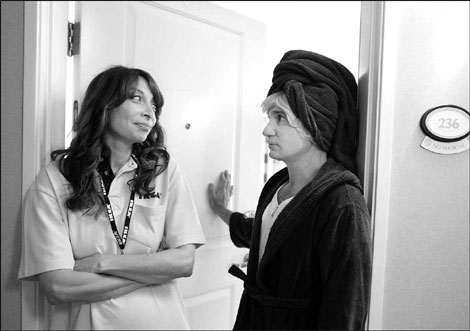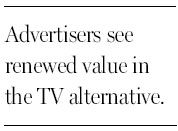New promise for Web videos
By Brian Stelter (China Daily)
Updated: 2010-08-22 10:09
 |
Large Medium Small |
 |
|
Illeana Douglas, left, persuaded Ikea to back her online series, called "Easy to Assemble." Kat Marcinowski[Photo/China Daily] |
LOS ANGELES - When Illeana Douglas, long active in independent film, wanted to make a show about a Hollywood actress who becomes a blue-collar worker, she turned to the Web and to an unusual ally, Ikea.
She persuaded the Swedish furniture maker to be the sole sponsor of her Web video show, "Easy to Assemble," in which she plays an employee. The most recent episodes, from October through February, drew more than 1.5 million views per month. "The brand is a co-worker in the story line," said Ms. Douglas, dressed in a yellow Ikea jumpsuit, mimicking her character.
Branded entertainment deals like the one by Ikea are becoming common, helping to nourish new programming. After a protracted drought, money is trickling back into the professional Web video industry.
And venture capital firms are also paying new attention to the industry. My Damn Channel, which distributes "Easy to Assemble," announced this month a $4.4 million infusion of financing.
The promise of Web video has risen and fallen over the last few years. What makes the current round of interest more compelling is the realization that Web video will not supplant television viewing anytime soon, just complement it.
"We realized we were putting a burden on Web-original programming by trying to make it like TV," said Lance Podell, the chief executive of the Next New Networks, who now calls his company a provider of "Web original programming."

The Web video industry is less visible, but together, the major players rack up hundreds of millions of video views each month.
As people spend more time online, producers are betting that video viewing times will grow in tandem.
According to the measurement firm comScore, 86 percent of Internet users in the United States watch at least one online video a month. Some shows originate on traditional TV, something that Hulu specializes in; others originate online, and that portion is growing.
"There's an inevitability to Web video that makes it exciting," said Rob Barnett, the chief executive of My Damn Channel, which features original comedy and music shows. "I often think of my daily business life as a guy running a cable network in the early 1980s," at the dawn of that medium, Mr. Barnett added. "There is, no matter how you slice it, a timeline for any new industry to grow."
Reaffirming its belief in made-for-the-Web programming, YouTube in July announced $5 million in grants for online producers. The grants will seed new content for YouTube, which has largely failed to persuade big television networks and studios to place TV episodes and films on the site. Encouraging more professional Web video is another way for YouTube to expand its inventory for advertisers.
Web video companies say that advertisers are starting to make million-dollar commitments, a big improvement for sites that started out making $5,000 at a time. Commercials in front of professionally produced entertainment videos can command $15 to $35 per thousand views, while banner ads alongside the videos can run $5 to $15 per thousand views.
The ad revenue is important, but companies like My Damn Channel say they make more money from branded entertainment deals, which incorporate advertisers into story lines.
Ms. Douglas would not disclose the amount that Ikea had paid for the two-year-old "Easy to Assemble," though she said the budget had increased for season two and again for season three, which is in production.
"Nobody doubts anymore that this is the best way to make entertainment," she said.
The New York Times